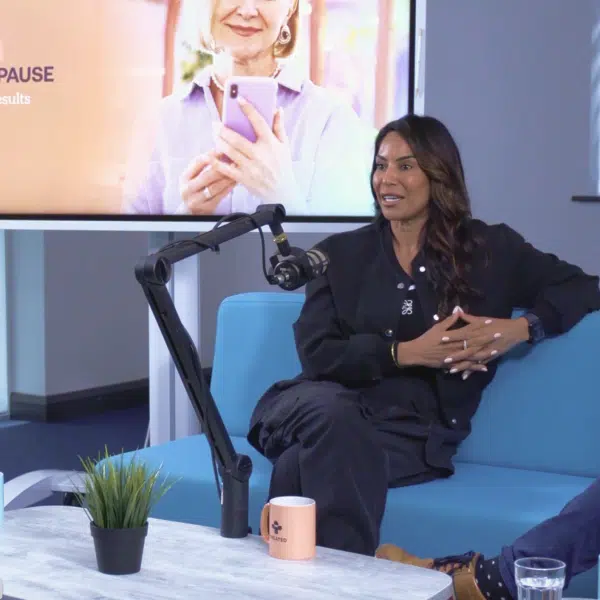HRT
Also known as 'HT' or menopause treatment
HRT, made easy.
Outside the US? Find us where you live.
Also known as 'HT' or menopause treatment
With so many treatments to choose from, finding the right HRT for you and your body isn’t always easy. We’re here to make it a whole lot simpler.
Take a consultation, order HRT online and we’ll check in with you regularly to see how you’re getting on with your medication.
HRT, or hormone replacement therapy, is treatment that women take to help relieve menopausal symptoms like night sweats, hot flashes, vaginal dryness, poor sleep, brain fog, mood swings and lower sex drive.
How long you take it for can vary; many women take it for a year or two but some can take it for much longer than this. It’s a very individual thing. Certain types of HRT will also suit you more than others. When you take a consultation with us, the clinician can talk you through the different options, and help you to decide which one is right for you.
As you enter the menopause, the levels of estrogen that your body produces start to decrease, due to a shift in the balance of your sex hormones. This can cause symptoms such as hot flashes, night sweats and changes to your mood. HRT contains synthetic estrogen, which makes up for the natural estrogen you lose, and helps to relieve menopausal symptoms.
Combined forms of HRT also contain a second hormone: a synthetic form of progesterone. Without anything to keep it in check, estrogen may increase your risk of getting endometrial cancer, because it can cause the womb lining to thicken more than it should. The progesterone in combined HRT offers protection from this, keeping estrogen in line and reducing the risk of womb cancer developing. It’s more convenient to take combined HRT as a pill or patch which contains both progesterone and estrogen, but sometimes it’s better to take these separately.
If you’ve had a total hysterectomy though, because your womb has been removed, you’ll usually be prescribed estrogen only HRT.
The menopause can also cause your bones to become more fragile and more prone to breaking. HRT can provide some protection against osteoporosis by helping the bones to stay strong. HRT isn’t a primary treatment for osteoporosis though, so if you’re looking to use it for this purpose, just let the clinician know during your consultation and they can chat to you about it.
The major benefit of HRT is that it can help to ease many symptoms of the menopause by as much as 75%.
The estrogen and progesterone in combined HRT make a good team. The estrogen helps to manage symptoms of the menopause whilst the progesterone helps to keep it in check and reduces your cancer risk.
And there’s the protection it can provide from osteoporosis too, when the bones in the body are more at risk of breaking or becoming brittle after the menopause.

How we source info.
When we present you with stats, data, opinion or a consensus, we’ll tell you where this came from. And we’ll only present data as clinically reliable if it’s come from a reputable source, such as a state or government-funded health body, a peer-reviewed medical journal, or a recognised analytics or data body. Read more in our editorial policy.
There are a number of different types of HRT available, and the clinician can show you some options when you take a consultation.
Tablets are one of the most widely used types of HRT. There are tablet options for both combined HRT and estrogen only HRT, and you normally take them once every day. They do carry a slightly increased risk of blood clots and breast cancer than other forms of HRT treatment, but it is only a small increase (nine more women develop a blood clot for every 10,000 women each year). Because of this increased breast cancer risk, make sure you attend your breast cancer screening (mammogram) appointments.
If you find having to remember to take a tablet every day a little inconvenient, skin patches may be a more low maintenance medication for you and they’re safer for your heart than tablets. You stick HRT patches to your skin, and change them twice a week. They’re available as a combined HRT treatment or as an oestrogen only medication. Skin patches can be a good option if you’re prone to side effects such as indigestion, and they don’t increase your risk at all of developing a blood clot, unlike tablets.
More and more women are starting to use estrogen gel for menopausal symptoms, and it’s probably because it’s really easy to use. You just need to rub it onto your skin once a day. It doesn’t increase your blood clot risk either, but if you still have your womb, you’ll need to use an additional progesterone to limit your risk of womb cancer.
They’re not particularly common, but you can also get a HRT implant, which releases estrogen slowly into the body and doesn’t need to be replaced for several months at a time. You’ll need to take a separate progesterone though if you’ve still got your womb.

How we source info.
When we present you with stats, data, opinion or a consensus, we’ll tell you where this came from. And we’ll only present data as clinically reliable if it’s come from a reputable source, such as a state or government-funded health body, a peer-reviewed medical journal, or a recognised analytics or data body. Read more in our editorial policy.
It depends on a number of factors, like what stage of the menopause you’re at, how sensitive you are to certain levels of hormones, and whether you prefer to take tablets or use patches, for example.
Whether or not you’ve had a total hysterectomy is also a factor, and if you have certain health conditions, that can play a big part too.
Here are your options. A clinician can talk you through them, and recommend safe and suitable HRT treatments just for you.
If you’re getting menopausal symptoms and still having your period, combined sequential (or cyclical) HRT treatments are usually recommended. Combined HRT is a type of treatment with two hormones: a progesterone and an estrogen. This can be given as two separate medications, but sometimes you’ll get a single treatment that contains both an estrogen and progesterone.
With sequential HRT, you start your cycle with estrogen only tablets (or patches) and then take a combination of estrogen and progesterone tablets (or patches) part way through your cycle.
You’ll see a regular bleed once per month with sequential HRT.
If you haven’t had a period for one year, you’re usually considered to be postmenopausal, and continuous combined HRT is normally recommended. With continuous combined HRT, you take a combination of estrogen and progesterone every day, without a break. So it’s a little different to sequential HRT. You won’t see any bleeding with continuous HRT, but if it’s less than a year since your last natural period, starting continuous HRT might lead to some unpredictable bleeding. So it’s best to start with sequential HRT.
Estrogen only treatments are normally recommended for women who have had their womb removed during a hysterectomy. They can also be used by women who still have their womb, but a separate progesterone is required (either as a tablet, a vaginal capsule, or a gel for the skin). Like continuous combined HRT, you typically take estrogen every day, without a break.
Side effects of HRT may also vary from one woman to the next, so some HRT medications won’t be safe (or suitable) for some women. If you’re more sensitive to estrogen, you may be better suited to lower-dose HRT. And if you have a particular health condition, this can mean that certain HRT medications won’t be safe for you to use either.
A clinician can identify which medications are appropriate for you and which aren’t, and make recommendations based on your medical background.
Tibolone isn’t available in the USA at the moment, but it is used by women in the UK and other countries. Also known as Livial, it’s used to relieve menopausal symptoms and as a preventative treatment for osteoporosis. It doesn’t contain any hormones, so it’s a little different to other forms of HRT, which contain estrogen and progesterone (or just estrogen).
Tibolone can help to ease symptoms like hot flushes, reduced sex drive and low mood, but research has suggested that Tibolone may be less effective than combined HRT. It’s also only a suitable option for women who are postmenopausal (so women who had their last period over a year ago).
Tibolone can cause side effects, including breast pain, vaginal discharge, pain in the pelvis, itching and abdominal pain.
The slightly increased risks of breast cancer and stroke that HRT carry are similar with Tibolone.
Clonidine is another prescription treatment that’s sometimes used to help tackle symptoms like hot flashes and night sweats. It’s a tablet that you take two or three times a day, and it has no effect on hormone levels, so there’s no increased risk of breast cancer for example. Studies suggest that it only has a small impact on easing flushing and night sweats though, and it can have unpleasant side effects too.

How we source info.
When we present you with stats, data, opinion or a consensus, we’ll tell you where this came from. And we’ll only present data as clinically reliable if it’s come from a reputable source, such as a state or government-funded health body, a peer-reviewed medical journal, or a recognised analytics or data body. Read more in our editorial policy.
Have something specific you want to know? Search our info below, or ask our experts a question if you can’t find what you’re looking for.
Menopause hormone therapy: latest developments and clinical practice. Drugs in Context. NCBI. . 2019; 8: 212551.
Use of hormone replacement therapy and risk of venous thromboembolism: nested case-control studies using the QResearch and CPRD databases. BMJ.
Short-term and long-term effects of tibolone in postmenopausal women.
Clonidine 25mcg Tablets BP - Summary of Product Characteristics (SmPC) - (emc).
Table 1: Summary of HRT risks and benefits during current use and current use plus post-treatment from age of menopause up to age 69 years, per 1000 women with 5 years or 10 years use of HRT.

A smaller estrogen-only patch that causes less skin irritation.

Slow-release ring that helps reduce menopause symptoms. Lasts for 90 days.

Easy to use patch that lasts 7 days. Treats hot flashes and reduces osteoporosis risks.

Natural progesterone in a soft gel capsule. Take alongside estrogen to keep your hormones balanced.

Available as a daily tablet or vaginal cream to target the symptoms that affect you most.

Registered with NPI (No. 1700446366)
Meet Laurenmarie
Registered with GMC (No. 4624794)
Meet Daniel
Registered with NPI (No. 1043478878)
Meet Joseph
Always read the leaflet that comes with your medication and tell us about any side effects you get.
We know health, but you know you.
Our experts tell you what’s safe, but you decide what’s best.
Answer a few questions and tell us about yourself. Get tailored advice from our clinicians so you can choose better.
Choose your treatment and how often you have it delivered.
We know things change. It’s the nature of life. We’ll check in regularly to make sure your treatment is still right for you.
Pause. Change. Skip. Start again. Any time you like.
Here are some other things we can help with.
Pill, patch, ring. We offer a range of birth control options so you can choose the one that's right for you.
All the info related to HRT you could ever need.
Take a look at our health guides.

Find treatment Male health Erectile dysfunction Hair loss See more treatments Female health Birth control See more treatments General health Weight loss Stop smoking See more treatments Popular treatments Sildenafil (Erectile dysfunction) Propecia (Hair loss) Yasmin (Birth control) Saxenda (Weight loss) See more treatments FAQ Search Sign in Contact us Fact checked Fact […]
Read more
To get ready for World Menopause Month in October, we’re launching Let’s Talk Menopause.
Read moreWe're making healthcare more about you. Sign up to our newsletter for personalised health articles that make a difference.
Disclaimer: The information provided on this page is not a substitute for professional medical advice, diagnosis, or treatment. If you have any questions or concerns about your health, please talk to a doctor.
We couldn't find what you're looking for.
Here's everything we treat. Or, if you're looking for something we don't have yet, you can suggest something.
If there’s a particular treatment or condition you’re looking for, tell us and we’ll look into it for you.
Submit your question here, or tell us if you’ve found an issue on our site.
You can continue as a guest, or sign in with your Treated account if you have one.
By clicking 'Subscribe now' you're agreeing to our Privacy Policy.
You’re signed up to our newsletter. Keep an eye on your inbox for our latest update.
We’ll get back to you very soon. We aim to respond to all queries in one working day.
We’ve sent you an email asking you to confirm your email address.